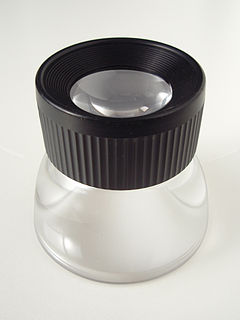 W
WA burning glass or burning lens is a large convex lens that can concentrate the sun's rays onto a small area, heating up the area and thus resulting in ignition of the exposed surface. Burning mirrors achieve a similar effect by using reflecting surfaces to focus the light. They were used in 18th-century chemical studies for burning materials in closed glass vessels where the products of combustion could be trapped for analysis. The burning glass was a useful contrivance in the days before electrical ignition was easily achieved.
 W
WA Coddington magnifier is a magnifying glass consisting of a single very thick lens with a central deep groove diaphragm at the equator, thus limiting the rays to those close to the axis, which minimizes spherical aberration. This allows for greater magnification than a conventional magnifying glass, typically 10× up to 20×. Most single lens magnifiers are limited to 5× or so before significant distortion occurs. The drawback is that the diaphragm groove reduces the area seen through the magnifier.
 W
WA dome magnifier is a dome-shaped magnifying device made of glass or acrylic plastic, used to enlarge words on a page or computer screen. They are plano-convex lenses: the flat (planar) surface is placed on the object to be magnified, and the convex (dome) surface provides the enlargement. They usually provide between 1.8× and 6× magnification. Dome magnifiers are often used by the visually impaired. They are good for reading maps or basic text and their inherent 180° design naturally amplifies illumination from ambient side-light. They are suitable for people with tremors or impaired motor skills, because they are held in contact with the page during use.
 W
WA linen tester is a strong magnifier with a measuring scale and a built-in stand.
 W
WA loupe is a simple, small magnification device used to see small details more closely. Unlike a magnifying glass, a loupe does not have an attached handle, and its focusing lens(es) are contained in an opaque cylinder or cone or fold into an enclosing housing that protects the lenses when not in use. Loupes are also called hand lenses.
 W
WA magnifying glass is a convex lens that is used to produce a magnified image of an object. The lens is usually mounted in a frame with a handle. A magnifying glass can be used to focus light, such as to concentrate the sun's radiation to create a hot spot at the focus for fire starting.
 W
WA reading stone is an approximately hemispherical lens that can be placed on top of text to magnify the letters so that people with presbyopia can read it more easily. Reading stones were among the earliest common uses of lenses.
 W
WA Stanhope lens is a simple, one-piece microscope invented by Charles, the third Earl of Stanhope. It is a cylinder of glass with each end curved outwards, one being more convex than the other. The focal length of the apparatus is at or within the device so that objects to be studied are placed close to or in contact with the less curved end. Because its construction is simple and economical, it was popular in the 19th century. It was useful in medical practice for examining transparent materials such as crystals and fluids.